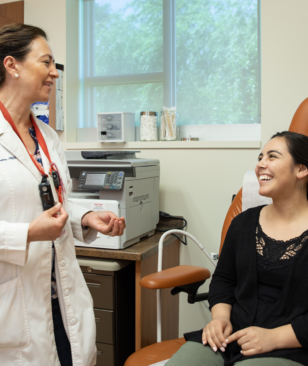 Providers want their patients to feel their best physically and mentally. So, if they could dramatically improve treatment plans and health outcomes for their patients, they would want to do that, right?
Providers want their patients to feel their best physically and mentally. So, if they could dramatically improve treatment plans and health outcomes for their patients, they would want to do that, right?
Recently, there has been increased recognition of the role trauma and adverse childhood experiences (ACEs) play in both the physical and mental health of people and populations. And though the COVID-19 pandemic has placed a spotlight on collective trauma across the world, trauma is not unique to this public health crisis. Helping patients connect their past and ongoing traumatic experiences to their current health and educating them about how to reduce toxic stress and address root causes of illness has the potential to improve the way providers care for their patients.
To help practices meet this growing need, Primary Care Development Corporation (PCDC) released a roadmap, “Supporting Small but Mighty Practices in Implementing ACE Screening & Trauma-Informed Care.” These recommendations were developed through a year-long series of provider engagement and virtual learning sessions conducted between 2020 and 2021 as part of the ACEs Aware initiative, funded and led by the California Office of the California Surgeon General Department of Healthcare Services to give Medi-Cal providers training and support in implementing ACEs screening.
In a recent conversation, PCDC sat down with Yael Lipton, MPH, MCHES, Training and Curriculum Development Specialist, to discuss highlights from the practice paper.
What are some key takeaways about this practice paper?
Health care practices that implement any aspect of trauma-informed care will likely see benefits in how patients respond to staff and treatment plans. Even though completely transforming a health care practice to be trauma-informed can be a lengthy and involved process, this paper details many things that practices and staff can do immediately that should have an impact on patient care and outcomes. While screening for ACEs and other types of trauma does require preparation (e.g., training for staff, choosing a tool, determining who and when the screening will take place, etc.) and a change in workflow, the potential benefits may be felt immediately both by the health care team and patients.
What can providers do to incorporate trauma-informed care (TIC) within their practice?
The first and most fundamental step is to develop a trauma-informed and person-centered framework for both patients and staff. Within clinical encounters, providers can create safe spaces for patients by being open and transparent about what they can and cannot help with, what to expect during the visit, who else will be involved and their role, ensuring confidentiality, and asking patients more about their life experiences and incorporating those life experiences into treatment plans so that other drivers of health (e.g., food security, housing issues, etc.) are addressed. Another critical component of TIC is screening for ACEs and other trauma with the intent to identify patients at risk for toxic stressors and then implementing strategies to reduce the impacts of those stressors. Finally, practices must prevent secondary traumatic stress in staff. Working with patients who have experienced trauma can cause burnout, compassion fatigue, and vicarious trauma. By addressing staff wellness, practices can create a safe space for their own staff that promotes well-being and joy in work.
What are next steps that the health care community should consider based on the findings within the paper?
Practices and providers play a crucial role in helping trauma survivors feel safe and comfortable in health care settings. The steps outlined in this paper are meant to show the actions they can take—both big and small— to address trauma and stress within every visit. Practices of any size can improve the health trajectories of their communities by acknowledging their patients’ experiences. By implementing these tools and strategies, providers and staff are honoring their patients, improving access to care, and maintaining an open door to health promotion. The most important thing is to get started.

